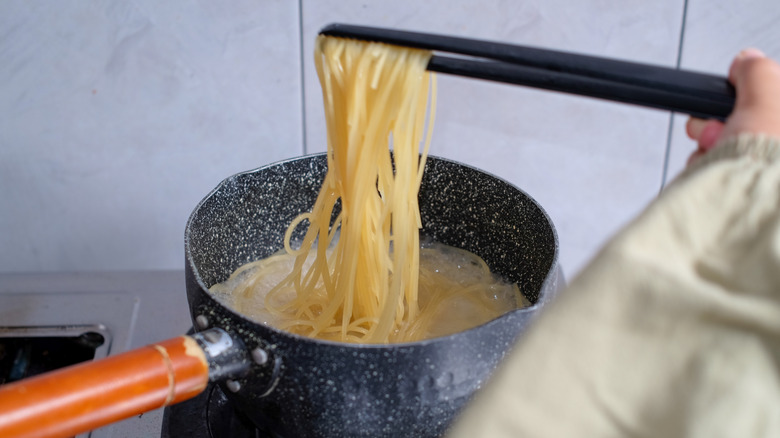Transform Pasta Into Another Beloved Noodle Dish With Baking Soda
Pasta is one of those simple yet transformative foods that serves as the foundation for some of the world's most decadent and timeless recipes. From spaghetti and meatballs to deep dish lasagna and no-frills cacio e pepe, these sacred starches are enjoyed in countless ways. Indeed, noodles are a near-universal culinary language. Take Japanese ramen noodles, for example, which, with the help of baking soda, can be swapped for Italian pasta in a pinch.
Although using pasta in place of proper ramen noodles may sound like blasphemy, it's more of a creative workaround than an upgrade, but it does have its fans. In fact, the technique is approved by professionals like "Top Chef" finalist Shota Nakajima, who showcased the technique on TikTok, calling them "cheat noods."
If you were wondering how baking soda transforms ordinary pasta into ramen noodles, it's not magic that makes traditional ramen strands so springy and firm – it's kansui, an alkaline mineral powder that transforms the wheat dough used to make the noodles. Baking soda is also an alkaline powder, so adding a pinch to pasta water yields a noodle with that bouncy, curly quality characteristic of high-quality ramen. Not only does bicarbonate of soda alter the structure of the pasta, but it also deepens its color, giving it a more authentic ramen aesthetic. Although baking soda-infused pasta isn't a dead ringer for genuine ramen noodles, this is one jjjjjjjjcrave-curbing hack that satisfies with little effort.
Tips for making pasta ramen
Turning pasta into ramen noodles is as easy as adding baking soda to your cooking water. But like any recipe or kitchen hack, keeping a few tips in mind will ensure the best results. For starters, selecting the right type of pasta is essential for achieving a deceptive ramen noodle dupe. Although all pasta shapes are reformed under the spell of baking soda, it's best to select stringy shapes like spaghetti, linguine, bucatini, and angel hair, to stay true to ramen's slurpability.
The water-to-baking-soda ratio is equally as important as the pasta shape. Although baking soda isn't known to flaunt a distinct flavor profile of its own, it can shade pasta with a mineral-tinted taste that might disrupt the harmony of your ramen bowl. As a rule of thumb, you'll want a tablespoon of baking soda for every 4 cups of water, but the ideal ratio depends on your preferences. If your ramen broth is on the subtler side, consider using slightly less baking soda. Richer, heavier broths are better equipped to mask any mineral-forward flavors that might stick to the pasta. Rinsing after draining can also help remove unwanted flavors. Because it will react with water by fizzing and frothing, be careful not to haphazardly introduce baking soda into the simmering water. Add salt as you normally would when cooking pasta.
Next time you're in the mood for ramen but find yourself short on the traditional noodles, don't settle for the instant kind. Use a little bit of baking soda magic to achieve a brothy, pasta-filled bowl that's (almost) like the real deal.

